(William) Ian Strang, R.E., (11th April 1886 – 23rd March 1952) was a British draughtsman and etcher who specialised in topographical subjects and spent the last decade of his life living in Wavendon.
Strang was born in London, the eldest son of William Strang, R.A., LL.D., an internationally known etcher, and his wife Alice née Rogerson. He left Merchant Taylors’ School early to study at the Slade School of Art from 1902 until 1906 with Henry Tonks and under Jean-Paul Laurens at the Académie Julian in Paris, 1906–8. He travelled in Spain, France and Italy, drawing wherever he went. He became a skilled painter as well as a draughtsman and soon began to work at dry point and later at etching.
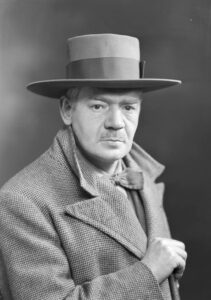
Strang held his first solo exhibition at the Goupil Gallery in 1914, but on the outbreak of War, he served in the Middlesex and Royal Berkshire Regiments and also worked as a camouflage officer until his demobilization in 1919 at the rank of Captain. He also produced some artworks during the War and the British War Memorials Committee purchased one large painting and several drawings of French battlefields from him. Some went to the Imperial War Museum.
From the working pencil drawings made to be etched, but often so good that they sold as finished pictures, there developed the more elaborate chalk drawings, which seemed as full of colour as a painting. John Fothergill called them “Photographs taken in Heaven”.
Strang exhibited at the New English Art Club from 1919 and the Royal Academy from 1923. He was an early member of the Society of Graphic Art and exhibited at their first annual exhibition in 1921. Strang was elected an Associate member of the Royal Society of Painter-Etchers and Engravers in 1925 and became a full member in 1930. He also visited and studied in Italy, Belgium, Spain and Sicily. Among his paintings was a notable portrait of James Dickson Innes. In 1944 Strang submitted five drawings of bomb-damaged buildings in central London to the War Artists’ Advisory Committee, WAAC, and the Committee purchased four of them. WAAC purchased a further two drawings of similar subjects in July 1945 for thirty guineas. His work appeared in many publications including Fine Prints of the Year and Print Collectors’ Quarterly.
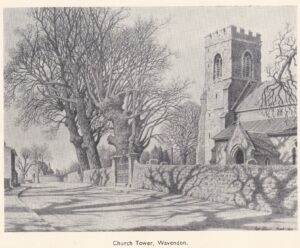
The Strangs moved to Wavendon during the Second World War, firstly to the Old Red House and later at the Old Manor and became a familiar sight out sketching the village. He was said to be pleased with the unspoiled corners of the village, the farmyards and hedgerow trees, the deeply rutted lanes and at the Plough inn, where the artist was wont to forgather in congenial company. Sets of his work decorated the bar and taproom and he also used prints of them as Christmas cards to his friends. His work on the Malting Yard was exhibited at the New English Art Club in 1946. He exhibited three chalk drawings at the Royal Academy, “The Fallen Tree”, “Buckinghamshire Village” and “Corner of a Village”, in 1951.
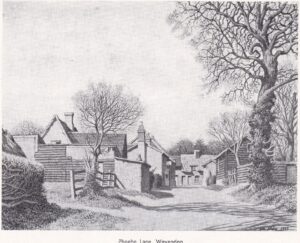
He died at Wavendon on 23rd March 1952. He was the President of North Bucks Art Society. A memorial exhibition was held at the Leicester Galleries in 1952. Strang was married to Frances and had a brother, David Strang (1887-1967), who was an artist and printmaker.
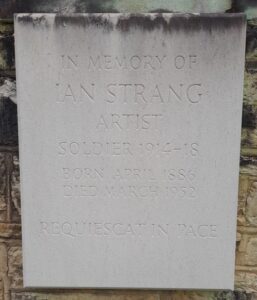
A memorial tablet to him was placed on the outside wall of the Nave of Wavendon St. Mary’s church. A memorial exhibition was held at the Leicester Galleries in 1952 and Bourne Fine Art held exhibitions of his work in 1999 and again in 2002.
Publications
“Town and Country in Southern France.” 1937. (with Frances Strang)
“The Student’s Book of Etching.” 1938.
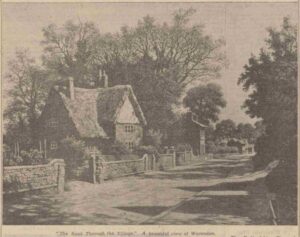
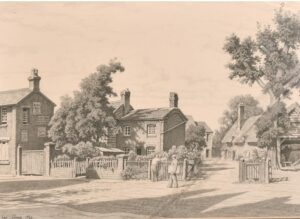
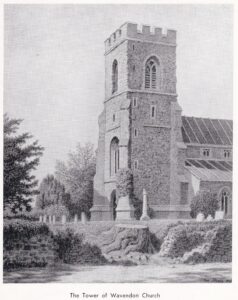
Several of his original works are still in the village, still proudly being displayed on householder’s walls!
[Compiled from his Wikipedia entry, the Beds Times obituary and various gallery websites.]
Last updated May 2023.
